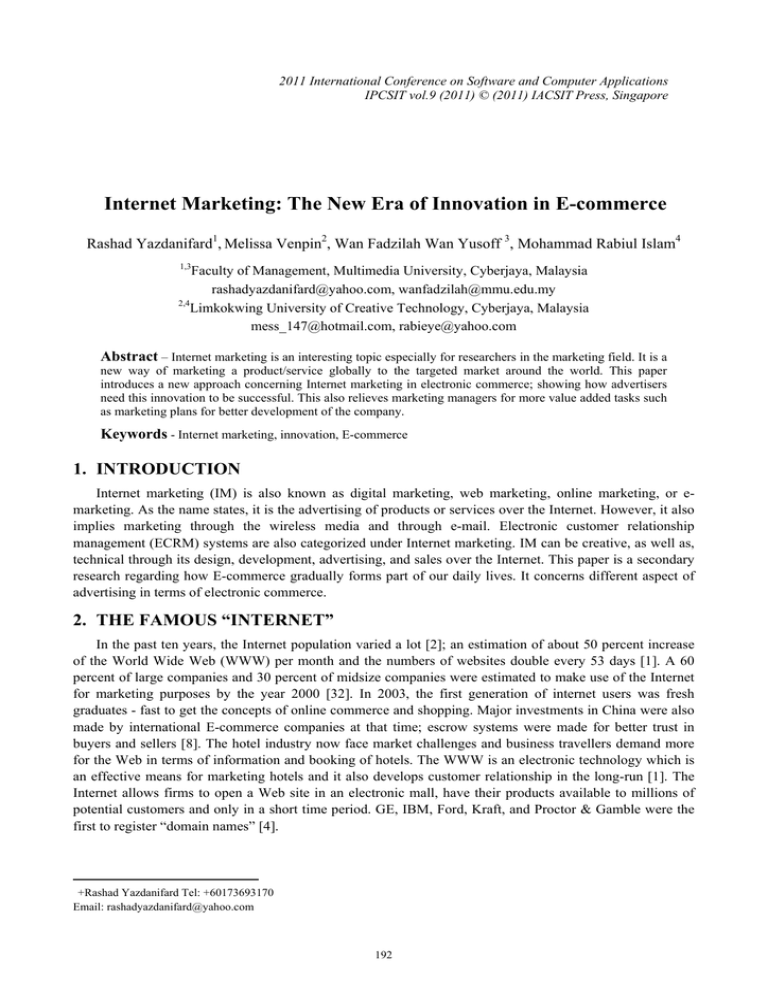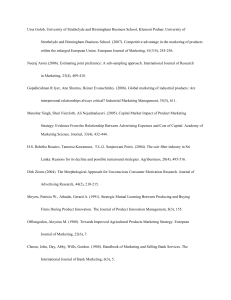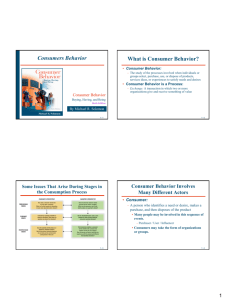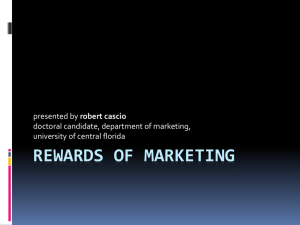Internet Marketing: The New Era of Innovation in E-commerce Rashad Yazdanifard ,
advertisement

2011 International Conference on Software and Computer Applications IPCSIT vol.9 (2011) © (2011) IACSIT Press, Singapore Internet Marketing: The New Era of Innovation in E-commerce Rashad Yazdanifard1, Melissa Venpin2, Wan Fadzilah Wan Yusoff 3, Mohammad Rabiul Islam4 1,3 Faculty of Management, Multimedia University, Cyberjaya, Malaysia rashadyazdanifard@yahoo.com, wanfadzilah@mmu.edu.my 2,4 Limkokwing University of Creative Technology, Cyberjaya, Malaysia mess_147@hotmail.com, rabieye@yahoo.com Abstract – Internet marketing is an interesting topic especially for researchers in the marketing field. It is a new way of marketing a product/service globally to the targeted market around the world. This paper introduces a new approach concerning Internet marketing in electronic commerce; showing how advertisers need this innovation to be successful. This also relieves marketing managers for more value added tasks such as marketing plans for better development of the company. Keywords - Internet marketing, innovation, E-commerce 1. INTRODUCTION Internet marketing (IM) is also known as digital marketing, web marketing, online marketing, or emarketing. As the name states, it is the advertising of products or services over the Internet. However, it also implies marketing through the wireless media and through e-mail. Electronic customer relationship management (ECRM) systems are also categorized under Internet marketing. IM can be creative, as well as, technical through its design, development, advertising, and sales over the Internet. This paper is a secondary research regarding how E-commerce gradually forms part of our daily lives. It concerns different aspect of advertising in terms of electronic commerce. 2. THE FAMOUS “INTERNET” In the past ten years, the Internet population varied a lot [2]; an estimation of about 50 percent increase of the World Wide Web (WWW) per month and the numbers of websites double every 53 days [1]. A 60 percent of large companies and 30 percent of midsize companies were estimated to make use of the Internet for marketing purposes by the year 2000 [32]. In 2003, the first generation of internet users was fresh graduates - fast to get the concepts of online commerce and shopping. Major investments in China were also made by international E-commerce companies at that time; escrow systems were made for better trust in buyers and sellers [8]. The hotel industry now face market challenges and business travellers demand more for the Web in terms of information and booking of hotels. The WWW is an electronic technology which is an effective means for marketing hotels and it also develops customer relationship in the long-run [1]. The Internet allows firms to open a Web site in an electronic mall, have their products available to millions of potential customers and only in a short time period. GE, IBM, Ford, Kraft, and Proctor & Gamble were the first to register “domain names” [4]. +Rashad Yazdanifard Tel: +60173693170 Email: rashadyazdanifard@yahoo.com 192 3. USE OF INTERNET FOR MARKETING SUCCESS Because Internet grew in only five years [18] and there are no barriers for time or location, marketing online has become the new era in E-commerce with petty variable cost per customer [23]. Marketers use full color advertising that appeal similar to both -young and old- to attract people all over the world. The Internet is now considered as a much greater resource than traditional means of advertising [4]: E-mail – use to transfer text and multimedia messages, Listservs [27] – latest information sent on specific themes to groups/managers, Newsgroup – electronic conferencing leading to the development of ideas, as well as, worldwide networking opportunities [6], File transfer protocol (FTP) – high speed file transfer as a virtual fax, WWW – menu-driven access to host resources [2], etc. All industries have subject matter experts (SMEs) [13] who are responsible to unify and apply knowledge from different vendors and sources to solve industry problems. To prepare a Web site merging SME knowledge with other reference sources is one of example of Internet model, [24] to retain and attract customers [6]. A well designed Web site can lead to an interesting, low cost means for sales promotion to worldwide customers [27]. Marketers should also refer to the AIDA model-Attention, Interest, Desire and Action- to successfully attract customers by introducing the right advertising on Internet [18]. 4. ADVANTAGES OF THE INTERNET Most people worldwide can use the Web since it is affordable and easy to access [5] [30]. Internet is a fast and flexible means for marketing [18]. Shopping on the Internet is convenient as there is no time restriction, it is comfortable since it is in a user friendly environment and there is also an instant satisfaction of ordering, paying and delivering [31]. A one-to-one basis, as well as, a two way communication with customers through the Internet is possible. Enhancing brand image, creating awareness and providing customer service are more important than just selling the products or entertaining customers [12]. With better technologies, companies can create a stronger brand image [18] and thus increase sales. It is easier to get customers’ feedbacks and use them to improve. On the other side, it is easier for customers to receive a kind of acknowledgement; feeling that they did not waste their time [3]. Nowadays, people live a busy life and shopping online is time consuming for them [4]. The company also saves time since whenever a customer uses his/her credit card to purchase a product, through the Web Trak software from Aurum Software, the company can access customers’ details [6]. Marketing communication includes expenditure on direct response marketing rather than the old standard mass communication; E-marketing is seen as a promotional as well as informational tool [25]. E-communities [19] or moderated group chat [20]-where customers with similar interests can interact-are strategies to build relations through Internet [18]. This new era of commerce is beneficial for marketing logistics [25], a global presence, to establish and maintain a competitive edge, shorten components of supply chains, for cost savings and research advantage [26]. 5. SUCCESSFUL WEBSITES For Web sites to be a success, it should be informative, entertaining, challenging, and unique [5]. The homepage should be short, clear and simple to avoid wasting the customer’s time. They should be understandable and easy to search information needed. Moreover, it must continuously be up-to-date for most recent information about the company; customers like to see modification in the website [4]. Products/services available should be represented clearly by key words or images on the Web site [7]. Programs should be set up to find out which kind of customers are interested and what can keep customers coming back. This is the key of marketing strategy to know your customers, as well as, what they want [4]. A company should create a Web site with unique SME knowledge and should not put Web links that are not completed [6]. There are different marketing strategies for the Internet: 1) Targeting – This is different from the traditional segmentation because the customers come to you, they initiate contact, control information flow and control message content. Accessibility is primordial for customers. Market the Web sites through packaging or “click-through” from other companies’ Web sites [5]. “Click-though” banner advertising is a sort of digital word-of-mouth which is becoming a stronger means of the Web [25]. 193 2) Product Strategy – Brand recognition is made clear on the Internet but the number of purchase is not there yet. Sometimes the products are not available on the Web site and consumers hesitate before getting this particular product. To increase their confidentiality, recognized vendors should be mentioned on the Net. Authenticity is important for both sellers and products. 3) Pricing Strategy – In the long run, it will be good if firms can concentrate on offering products with the unique characteristics. Online shoppers will differentiate by the benefits and quality of the products/services. Otherwise, a low price strategy should rely on cost advantage and high volume to be able to compete. 4) Distribution Strategy - There is a necessity of a direct-to-customer mechanism. The industry has to be the first providing unique services to always be ahead of competitors. 5) Promotional Strategy – This depends on the marketing research and consumer preferences. A “frequently asked questions” (FAQ) section should be provided in the Web site and high-level marketing officers should also be involved for a stronger marketing message for the company’s vision [5]. In fact, the FAQ, through Internet, can save over one million dollars by providing what customers want. It also reduces online catalogue processing costs and cycle time [6] [9]. Other than that, grouping and ranking the content of the Web site is effective so as to group consumer needs and to provide a good structure for navigation of the Web site according to a consumer [7]. 6. LINK TO REALITY Marketers should all know about information technology (IT) to be able to make better market analysis, decision making and to better control and monitor their field [9]. Competition must now be based on speed instead of size of corporations for development because product life cycles are too short to increase fast enough. What is needed are high quality information about the product, service and corporate needs and fast and effective delivery process. Continuous information-based value to customers can lead to comparative advantage [6]. Nowadays, traditional radio companies drive FM/AM and online listenership for a better growth by copying the best practices of new, growing internet companies [17]. Since Internet is innovating in a really fast way, companies need to continuously change and marketers agree that by the time a new product comes into the market, it will already be obsolete [31]. However, the Internet is not really safe since there are no modern online international payments systems resulting into frauds [30]. 7. DISCUSSION In the literature reviews, there is no negative growth of the Internet; in fact all the authors talk about the Internet as the new trend of this generation. However, traditional marketers somehow do not want to admit that the world changed. They are slow in taking advantages of new opportunities presented to them [17]. B2B-enhances supply chain process need to pay much attention to real-world business process, adapt automated systems to business behavior and mingle content and technologies with crucial information systems [11]. A simple company is changing toward this new era of innovation in e-commerce since companies want to reduce waste, order-to-delivery cycle time and unit cost. Because they want to develop flexible response, there is a need for Internet help and hence IM. There is a small amount of E-shoppers but this is because IM is just another channel of retailing and not a substitute of the traditional ones [27]. Most researchers suggested that face-to-face relationships are more efficient in the sense that marketers can see the instant reactions of the customers (first reaction is always the true one). However, E-mail is said to be more advantageous since it is cost effective, do not rely on time (time zone difference) and it can also transfer text and graphics [27]. The first driver to establish Internet is not financial return on investment (ROI) - It is qualitative marketing advantages for relationship of business with customers [6]. This was also shared by Michael Saren (2011) and Webster (1992) where customers focus, market segmentation, targeting and positioning; with the help of IT, will be the flexible bond maintaining all together. However, few companies use this communication tool to build relationship; instead they use it as a marketing tool to share information [21]. For customer relationship to take place and for E-success, company information provision and customer database information are necessary [12]. Marketers uses IM mostly to increase the sales and profit of the company, or to enhance brand image and customer relationship but according to Boutie’s (1997) 194 analysis of 100 Web sites and interviews, their objectives to communicate their product/service were incomprehensible [14]. Advertising objectives should be clear [4] [5] [7] so that customers know with which company they are buying from and whether they can trust that company or not. Another issue is that direct mail is said to be more effective than Internet advertising in E-commerce [15] but US direct mail is said to be reducing [16]. Most probably the Americans are more Internet users friendly; meaning that advertising will affect them better by browsing the Net than by reading their e-mails (which might be considered as spams). Although the Internet is of great benefits, it also has a lot of drawbacks. For instance, there are cultural and language barriers, as well as, the global reputation of the company [22]. The 4Ps play an important role here. Some products cannot be sold on Internet, promotions should be according to the culture and language of the targeted countries, price should be according to what consumers are willing to pay in bricks-andmortar stores and finally the distribution channel should be reachable from Internet users [29]. It is quite difficult to focus on only certain languages. That is why it is better to target a certain Internet consumers or make the advertising bias and multi-lingual. 8. CONCLUSION The Internet network is a marketing channel use by advertisers, marketers, and society to find the right combination of marketing mix to best suit customer’s needs. It is important for a company of this era to have access to the Internet to be more successful. Internet marketing does not only target consumers, but also Internet advertisements client marketers from companies. This is so because companies prefer to hire specialist in creating a Web site. People always find themselves under stress of working long hours and they do not have enough time for social activities or even shopping. They thus develop this new millennium where IM through E-commerce becomes an everyday thing and routine for them. E-mail is as famous as direct marketing in supporting E-commerce activities. Most clients feel that this new media is a success in relation to traditional marketing advertising. But Internet should be used with other media for a more effective marketing tool. Internet marketing will become even more important in the future [3] [4] [5]. As more companies will have access to the Internet, they will start doing business over the Internet [3] [5]. China’s economy will be in another dimension with E-commerce where customer focus, responsible business practices and innovation are the determinants of success and not customer relationship [8]. With a decrease in communication prices, more customers will shift to the Internet as well. Security will not be an issue anymore because software companies, banks and credit card institutions are working hand in hand to improve Internet security. Companies need to protect themselves in three areas: data integrity, confidentiality of data and authenticity by installing firewalls or routers. Customers will look for a business on the Web since there are unique opportunities for marketing a company’s service, selling products and gathering information on the Net [3]. The marketing mix plays an important role in IM in E-commerce; deciding what type of advertising best suit customers through the Web. This is the new era of innovation; where everyone will be interacting on the Web. Live video session will be available and a prospective customer may be able to talk to a customer representative directly over the Net [3] [5]. 9. REFERENCES [1] David C. Gilbert, Jan Powell-Perry and Sianandar Widijoso (1999), “Approaches by hotels to the use of the Internet as a relationship marketing tool”, Journal of Marketing Practice: Applied Marketing Science, Vol. 5 No. 1, pp. 21-38. [2] Eric Sandelands (1997), “Utilizing the Internet for marketing success”, Pricing Strategy & Practice, Volume 5, No 1, pp.7–12. [3] Karen A. Forcht and Rolf-Ascan Wex (1996), “Doing business on the Internet: marketing and security aspects”, Information Management & Computer Security, 4/4, pp. 3–9. [4] Paul Herbig and Brian Hale (1997), “Internet: the marketing challenge of the twentieth century”, Internet Research: Electronic Networking Applications and Policy, Volume 7, Number 2, pp. 95–100. [5] Alicia Aldridge, Karen Forcht and Joan Pierson (1997), “Get linked or get lost: marketing strategy for the Internet”, Internet Research: Electronic Networking Applications and Policy, Volume 7, Number 3, pp. 161–169. 195 [6] Joseph Heinen (1996), “Internet marketing practices”, Information Management & Computer Security, 4/5, pp. 714. [7] M.J. Taylor and D.England (2006), “Internet marketing: web site navigational design issues”, Marketing Intelligence & Planning, Vol. 24 No. 1, pp. 77-8. [8] Kerry Finch (2011), “Internet Marketing Grows in China”, Alternative energy, retrieved from EzineArticles.com [9] Michael Saren (2011), “Marketing empowerment and exclusion in the information age”, Marketing Intelligence & Planning, Vol. 29, No. 1, pp. 39-48. [10] Webster, F.E. (1992), “The changing role of marketing in the corporation”, Journal of Marketing, Vol. 56, October, pp. 1-17. [11] Mike Serve and Dave C. Yen (2002), “B2B-enhanced supply chain process: toward building virtual enterprise”, Business Process Management Journal, Vol. 8, No. 3, pp. 245-253. [12] Jonathan M. Lace (2004), “At the crossroads of marketing communications and the Internet: experiences of UK advertisers”, Internet Research, Vol. 14, No. 3, pp. 236–244. [13] Marquis, S. (2001), “Let’s not ignore the potential of the Web as a mass ad medium”, Marketing, March, p. 26. [14] Boutie, P. (1997), “Tales from the Web: What do Marketers Do on the Internet Today? What Works? Why?”, European Society for Opinion and Marketing Research (ESOMAR), Amsterdam. [15] Beardi, C. (2000), “E-commerce still favours traditional techniques”, Advertising Age, Vol. 71 No. 43, pp. 2-4. [16] Jupiter Internet (2003), “Internet Direct Marketing Model”, March, Jupiter Research, Darien, CT. [17] Stuart E. Jackson (2010), “New media: debunking the myths”, Journal of Business Strategy, VOL. 31, NO. 1, pp. 56-58. [18] Stephan lagrosen (2005), “Effects of the internet on the marketing communication of service companies”, Journal of Services Marketing, 19/2, pp. 63–69. [19] Barnatt, C. (1998), “Virtual communities and financial services – online business potentials and strategic choice”, International Journal of Bank Marketing, Vol. 16 No. 4, pp. 161-9. [20] van Dolen, W.M. and de Ruyter, K. (2002), “Moderated group chat: an empirical assessment of a new e-service encounter”, International Journal of Service Industry Management, Vol. 13 No. 5, pp. 496-511. [21] Arnott, D.C. and Bridgewater, S. (2002), “Internet, interaction and implications for marketing”, Marketing Intelligence & Planning, Vol. 20 No. 2, pp. 86-95. [22] T.C. Melewar and Nichola Smith (2003), “The Internet revolution: some global marketing implications”, Marketing Intelligence & Planning, 21/6, pp. 363-369. [23] Deighton, J. (1997), “Commentary on exploring the implications of the Internet for consumer marketing”, Academy of Marketing Science, vol.25 No.4, pp.329-46. [24] Strauss, J. and Frost, R. (1999), Marketing on the Internet: Principles of Online Marketing, Prentice-Hall, Upper Saddle River, NJ. [25] Stewart Adam, Rajendra Mulye, Kenneth R. Deans and Dayananda Pallhawadana (2002), “E-marketing in perspective: a three country comparison of business use of the Internet”, Marketing Intelligence & Planning, 20/4, pp. 243-251. [26] Ng, H.I., Pan, Y.J. and Wilson, T.D. (1998), “Business use of the World Wide Web: a report on further investigations”, International Journal of Information Management, Vol. 18 No. 5, pp.291-314. [27] Jim Hamill (1997), “The Internet and international marketing”, International Marketing Review, Vol. 14, No. 5, pp. 300-323. [28] Jennifer Rowley (1999), “Loyalty, the Internet and the weather: the changing nature of marketing information systems?”, Management Decision, 37/6, pp. 514-518. [29] Jun Yu (2006), “Marketing to Chinese consumers on the Internet”, Marketing Intelligence & Planning, Vol.24, No.4, pp.380-92. 196 [30] Roger Bennett (1997), “Export marketing and the Internet”, International Marketing Review, Vol. 14, No.5, pp. 324-344. [31] Peter R. J. Trim (2002), “Corporate intelligence and transformational marketing in the age of the Internet”, Marketing Intelligence & Planning, 20/5, pp. 259-268. [32] Crain’s Chicago Business (1994), “EU information technology: not yet on the Internet?”, Business Europe. 197





